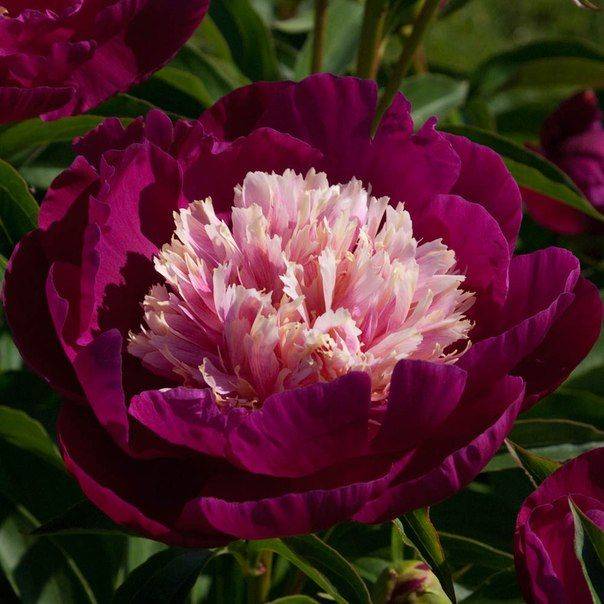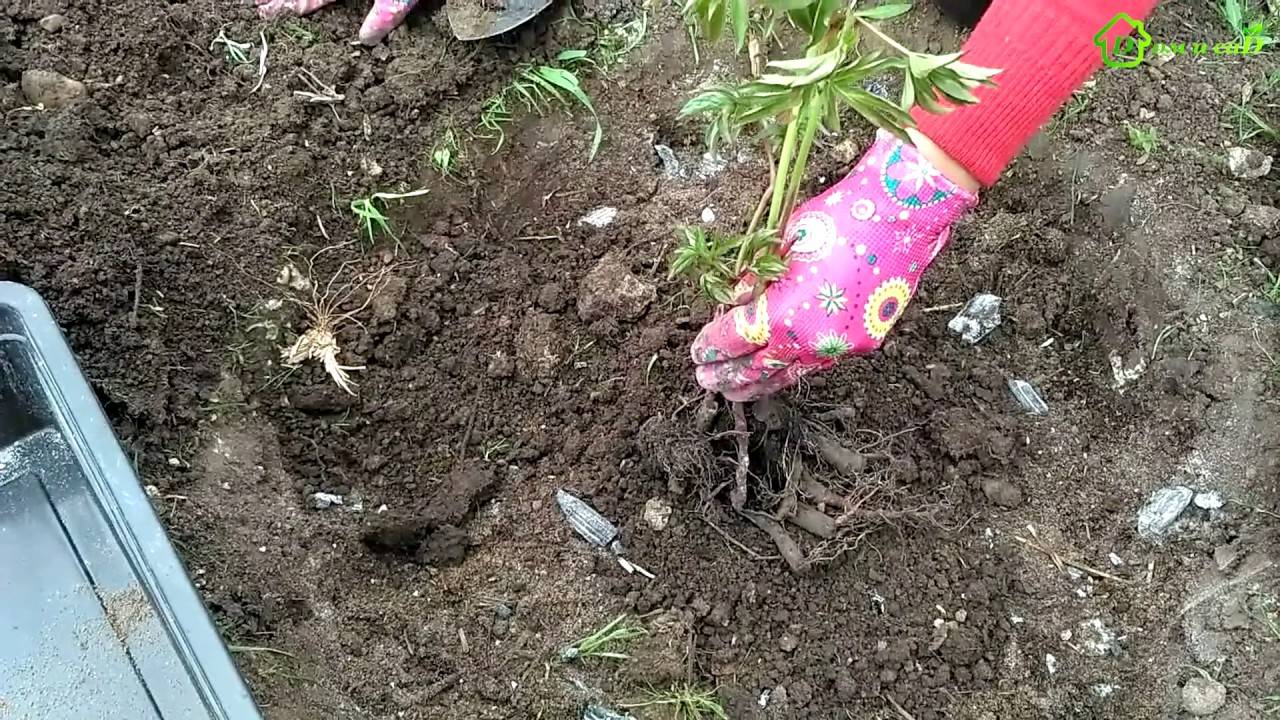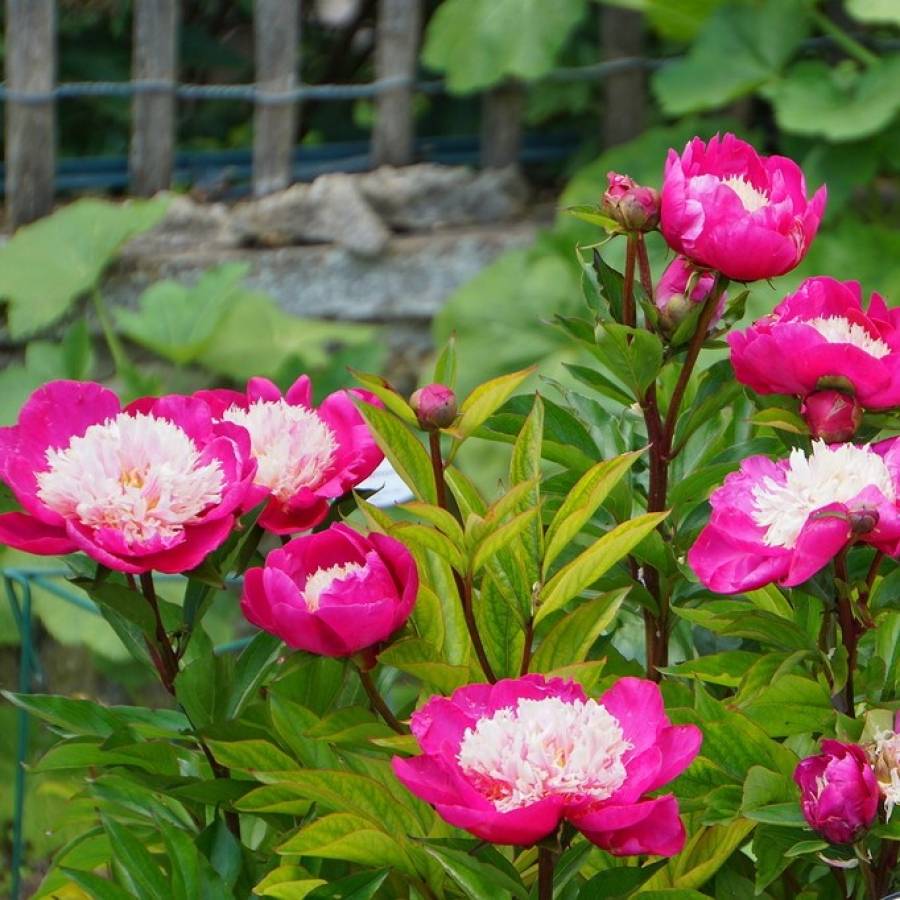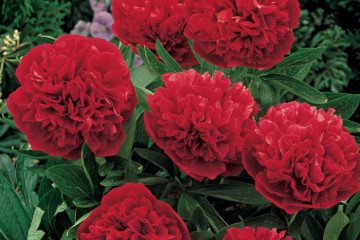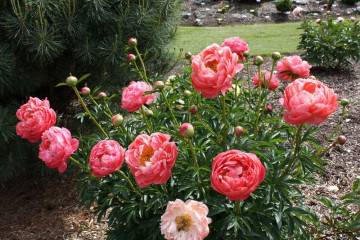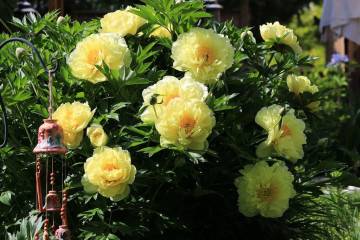Peony White Cap (Paeonia White Cap) - features of planting a flower
Content:
The White Cap peony variety is recognizable by the contrasting combination of light central petals and dark outer petals. The name White Cap peony means "white cap" in English. The middle of the bud changes color from pink to snow-white as it blooms. The author of the hybrid is American Winchel George. The year of creation - 1956. And now the White Cap lacto-flowered peony is popular all over the world.
Peony White Cap (Paeonia White Cap) - what is this variety, history of creation
The specific color of the flower attracts many gardeners.
Brief description, characteristic
Characteristic features of the hybrid:
- foliage is dark green, pointed;
- flowers are terry, spherical;
- bush height - up to 80 cm;
- in each bud there are 5-10 petals collected in 1-2 rows.
Advantages and disadvantages of the variety
White Cap belongs to the group of Japanese peonies, the class of milk-flowering. The variety has all the advantages of these groups.
Benefits:
- friendly flowering;
- high decorativeness;
- frost resistance;
- does not need frequent transplants;
- unpretentiousness;
- compact bush;
- stiff peduncles.
Disadvantages:
- during flowering, a bush without support can fall apart.
Use in landscape design
Compact shrubs of the herbaceous White peony are ideal for group plantings, as a single plant, in curbs and parapets. Groups of different varieties of peonies are especially good. Peony White Cup goes well with pink peony Edulis Superba.
Growing a flower, how to plant it in open ground
To grow healthy, abundantly flowering bushes, you need to follow certain rules.
Planting by root cuttings
Root cuttings are areas of the rhizome, 2-5 cm long. Such a cutting necessarily contains a bud and a root. Harvesting of planting material is carried out in July-August. Propagation by root cuttings is carried out according to the following algorithm:
- Dig up the rhizome, remove old roots and earth.
- Divide the rhizome into cuttings.
- Disinfect the cuttings by soaking them for 2 hours in a pink solution of potassium permanganate.
- Dry the planting material, sprinkle the sections with crushed coal, leave to dry overnight.
- In the prepared bed, plant the cuttings at a distance of 15 cm from each other.
The plot with cuttings is shaded from the sun, regularly watered, weeds are weeded, mulch for the winter. The first flowers will appear on plants in 3 years.
What time is the boarding
Most often, a peony is propagated by dividing the rhizome. The most suitable time for planting a peony: late April - early May and late August - early September. During these periods, the formation of an "active" root system occurs, those roots that suck water from the soil.
Location selection
Can grow in one place and feel great up to 30 years old. Conditions for landing:
- open, sunny place, in the shade the peony will not bloom;
- nutritious soil, loose;
- groundwater at the site should not be close;
- high-quality drainage;
- the absence of other perennials, buildings nearby;
How to prepare the soil and flower for planting
The site for planting the White peony variety is prepared in three to four weeks:
- Digging a hole with a depth and diameter of 60 cm.
- At the bottom, 10 cm of drainage is laid (expanded clay, broken brick).
- The hole is filled ½ with a mixture of soil, forming a mound.
Plant preparation:
- All the stems of the selected plant are cut off.
- Carefully dig out the root system, being careful not to damage the adventitious roots.
- The soil is removed from the roots so that the buds are visible.
- The accessory roots are cut, leaving 10-12 cm.
- Rotten, dried out areas of rhizomes are removed, cuts are sprinkled with crushed coal.
- The rhizome with a pruner or a sharp knife is divided into parts so that in each division there are 2-3 developed buds and 2 adventitious roots.
Planting procedure step by step
In order for the peony to quickly take root and begin to bloom, it must be planted correctly:
- The rhizomes are placed in a prepared and well-spilled hole.
- The upper kidney is positioned flush with the ground.
- They fill the hole with soil, compacting it.
- The landing site is mulched with hay, sawdust.
- Watering.
Planting with seeds (for breeding)
Getting seeds is troublesome, many hybrids do not bear fruit at all. Peony seed propagation features:
- peony seeds peony White Cap tightly similar;
- only every fifth or sixth seed from those planted germinates;
- flowers on peonies grown from seeds will appear only 6-7 years after planting.
The collection of seeds is carried out in August, when the capsules have just begun to open. The seeds are placed in a container with calcined wet sand.
A two-stage stratification is carried out:
- Heat stratification. Wet sand with seeds is heated twice to +30 ° C. After heating, the sand is cooled to room temperature and watered.
- Cold stratification. The seeds germinated in the sand are transferred to peat pots. Seedlings are kept for 3 months at a temperature of + 5 ... + 10 ° С.
After the stages of stratification, young peonies are transferred to a room, where they live until May, when they can be transplanted into open ground.
Plant care
Peony is one of the most unpretentious garden plants. To grow a healthy and abundantly flowering bush, certain agrotechnical measures are necessary.
Watering and feeding
Top dressing of the White Cap peony is carried out according to the scheme:
- in late March - early April, nitrogen and potassium are introduced;
- at the very beginning of flowering - complex fertilizer;
- after the end of flowering - potassium and phosphorus.
Peony watering rules:
- water temperature for irrigation - at least 20 ° С. The roots do not absorb cold water.
- do not allow the soil to dry out;
- water abundantly, but not until moisture stagnates in the soil;
- watering is carried out at the root, preferably in the evening or in the morning.
Mulching and loosening
You need to loosen the soil around the bush after each watering. Loosening depth - 5-7 cm. The procedure is necessary to improve root respiration.
Mulching the soil around the plants is recommended to get rid of weeds and regulate soil moisture.
Peony Blossom White Cap
The variety is medium-late, its flowers bloom in mid-May.
A period of activity and rest
All peonies have two periods of active growth of the root system:
- In the spring, after the soil temperature rises to +5 ° C and until the end of flowering.
- In autumn, when the suction roots turn into storing rhizomes, thanks to which the peony hibernates.
Care during and after flowering
At the very beginning of flowering, the side buds on the bush are plucked, this will make it possible for the central ones to become larger.
What to do if it does not bloom: possible reasons
Factors that provoke the lack of flowering:
- unsuitable landing site;
- bush under 2 years old;
- strong deepening when landing;
- the bush has been growing in one place for more than 30 years, requires rejuvenation;
- excess nitrogen in the top dressing. This is noticeable by the rich greenery, powerful leaves and stems;
- acidic soil;
- the roots of the plant are affected by nematodes.
Peonies after flowering
After flowering, the plant needs to create conditions for recuperation and give the opportunity to prepare for the next summer.
Transfer
Immediately after flowering, the peony cannot be transplanted. You need to give the plant time to regenerate.
Pruning
The peony is by no means cut off immediately after flowering! Otherwise, the bush will not store nutrients for the winter and for flowering next spring.
Preparing for winter
Sanitary pruning is carried out at the end of October. Shoots are cut, leaving 10 cm. After cutting, the soil is mulched with a thick layer of sawdust or straw (10-15 cm).
Preventive treatments
As a prevention of the appearance of rot and rust, peony bushes are treated with a fungicide in early April, in the first and last ten days of May.
Diseases, pests and ways to control them
Peony White Cap is resistant to diseases and pests. In rare cases, it can be affected by gray and root rot, rust, spotting. All these are fungal diseases. Fight against fungi:
- Establish an irrigation regime.
- Treat the bushes with a fungicide or Bordeaux liquid.
- Don't forget about autumn pruning.
Pests
Parasites that can infect peony are root-knot nematodes. There are no methods of dealing with nematodes. A sick bush is dug up and burned.
Peony is one of the most popular garden plants. Bouquets from it are always attractive. This flower is especially loved in China.
